Market Breadth using the New High New Low ratio and the Cumulative Advance Decline line for the NYSE and NASDAQ.
I’ll let the charts do the talking…
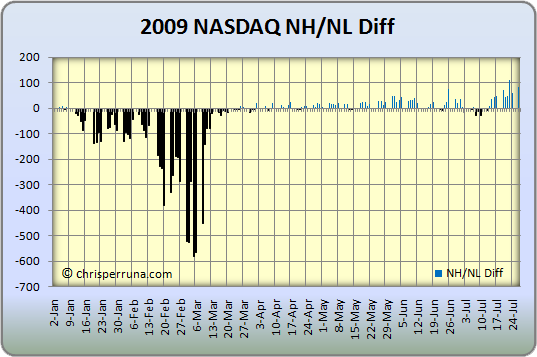
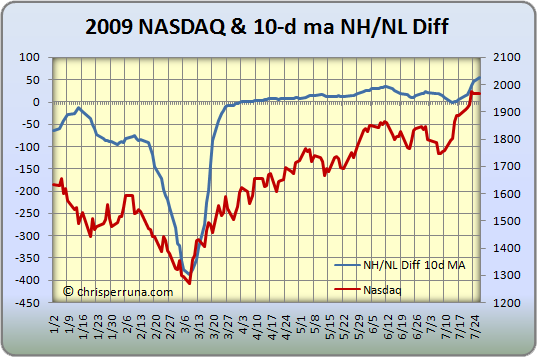
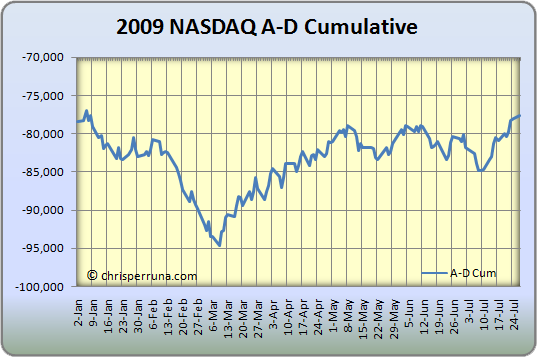
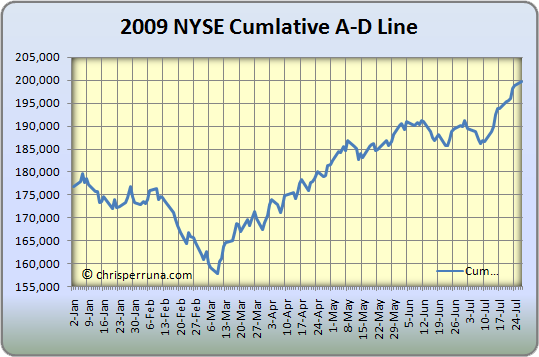
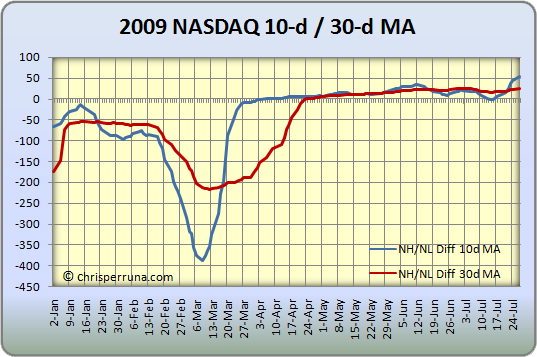
A blog about trading, finances, success and life itself
Market Breadth using the New High New Low ratio and the Cumulative Advance Decline line for the NYSE and NASDAQ.
I’ll let the charts do the talking…





Do you really want to know how to pick market tops and bottoms? Really?
Well, you don’t need a crystal ball, you don’t need any Wall Street guru’s, you certainly don’t need fancy computer software and you can simply ignore the talking heads. It’s that easy. Maybe we won’t pick absolute tops and bottoms but we can identify trends as they begin to develop.
You just need to follow the action among the individual stocks in the market! Learn to focus on the number of stocks making new highs versus the number of stocks making new lows. It’s been the true crystal ball in my method since I started to turn a consistent profit in 2002. It’s the backbone of my trend following methods.
The NH-NL Differential is simply the number of stocks making new highs minus the number of stocks making new lows.
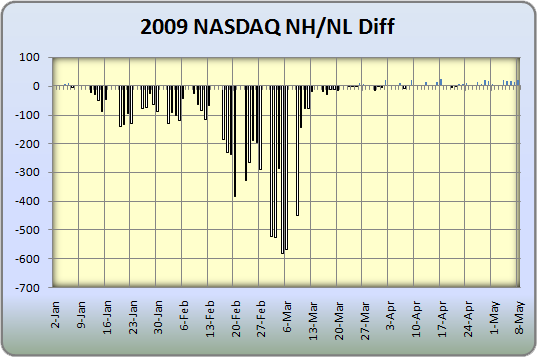
I follow the progress of stocks making new highs and new lows on the NASDAQ and NYSE and pay specific attention to turning points in the differential. I am not so interested in the extreme highs or lows of the ratio but rather changes in trend from positive to negative and negative to positive over a period of time.
The yearly Nasdaq New Highs and New Lows (Differential) are captured in my charts below, dating back 10 years. With many market pundits (or talking heads) saying that we may have reached a bottom, I felt it was time to do some homework and study the past charts so we know what to look for in 2009. It is true that the trend seems to be changing but we aren’t quite there yet. Focus on 2002 and 2003 to get an idea of what we may see if this market decides to make a true up-trending run, one that’s sustainable.
Consistent Nasdaq readings above 100-200+ will be the official confirmation to grab and add shares for trend traders!
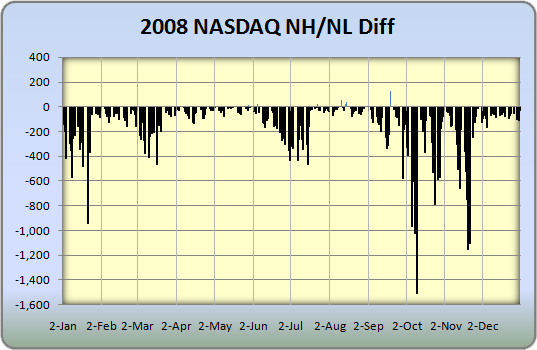
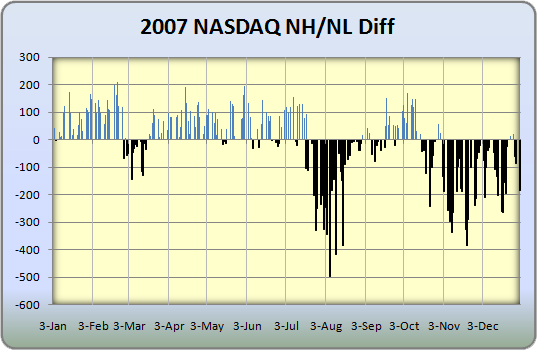
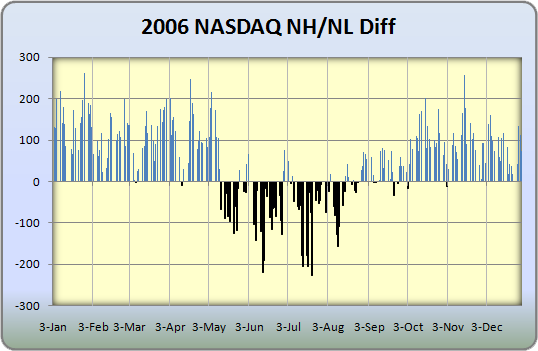
Every once in a while you like to look back and review your notes to locate where your research was right and where it was wrong. The simple technique of following stock market leaders and the NH-NL ratio nailed the period of time when the market transitioned from an up-trend to churning to the “Big Decline”. We nailed it here on this blog and every reader was prepared for the imminent decline. No one can dispute that. Readers of this blog were told to move to cash to preserve capital in late 2007 and early 2008. Now, I am not talking about day traders but longer term traders or investors that work full time and do what I do.
The chart highlights in red where I was making the sell posts (the articles are listed below):
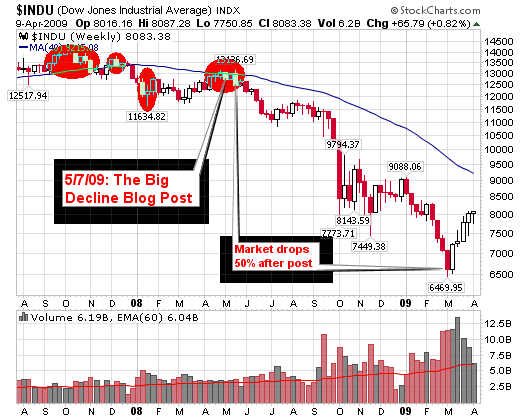
Anyway, I have been posting twits about the strengthening of the NH-NL ratio which is starting to tell me that the newest trend change is beginning. Yes, this is my first major blog post saying that my screens (market tools) are telling me to wake up because things are starting to change. It’s not time to jump in with both feet and buy every stock that’s up on above average volume but it’s time to sharpen the skills and be ready. We may look back and point to March and April of 2009 as the bottom of the market or at least the start of the changing trend.
We don’t have market leaders yet but when they appear, I will locate them, post up charts and talk about them nightly on twitter (twitter.com/cperruna). Too many stocks still have their 50-d moving averages below their longer term 200-d moving averages and new highs are still limited. However, new lows have dried up considerably and the NH-NL ratio has a moving average that is trending higher for about a month now. That’s the most sustainable trend for this ratio since the big decline started.
Stay tuned to the blog and my twits for follow-ups to my research on individual stocks and the overall trend.
In the meantime, take a look back at the numerous blog articles I posted in 2007and 2008 talking about a market decline, shorting stocks and selling in general. Learn from what the simple tools were telling us. I am far from a market genius and far from rich but I can make a few dollars following the leaders and the NH-NL ratio.
A Review of Articles Pointing to a Stock Market Decline in early 2008:
The bottom line or point of today’s rant is the fact that I still feel that the market is headed for a decline or as I phrased it a couple weeks ago: The Big Decline (long term perspective of course).
I originally started to point out market troubles back on March 14, 2008 in a post titled Snapshot Friday; I highlighted both the Dow Jones and NASDAQ with clear yellow shaded areas showing the 200-day moving averages pointing down for the first time since 2003 (that’s huge if you ask me).
I am a positive person by nature and I prefer to buy stocks going up but I am starting to see several leading stocks struggle to hold new highs or fail to challenge recent highs. These patterns are familiar and they are suggesting that the recent bounce is the final stage before a possible market decline.
I wrote an article on October 15, 2007 titled How to Make Money Selling Short, precisely when the general market indexes were topping. I am not going to take full credit but subconsciously my charts were giving me signals that the market was showing the major red flags and signals of what we are seeing today.
A Review of Articles Talking about Selling, Profit Taking and Market Distribution in late 2007:
Well, the current two year rise of the Shanghai Stock Exchange Composite Index looks remarkably similar to the rise of the NASDAQ of the late 1990’s and the charts below explain better than I can!
What do you do in a market like today when you have profits in multiple positions but you don’t want to give it all back? You want to continue to ride the winners but at the same time, you want to maintain the unrealized gains in your account. HOW?
This was the largest showing of volume in two months and is not healthy because it was pure distribution. It was only the second distribution day over the past month so we can’t call this a bear run but please be on the lookout for a possible correction of 5%-10%. Technology stocks led the decline as BIDU gave back 10% of its amazing run.
“Depression is the aftermath of credit expansion.” – Ludwig von Mises
I’d love to find someone that can venture through a single day without reading, hearing or talking about the current state of the economy, the stimulus plan, the bailouts or ponzi schemes. It’s sickening but what’s worse is the fact how NO ONE talks about fixing the problem correctly. Does anyone learn from the past?
I didn’t read the stimulus package in its entirety (it appears that our representatives didn’t either) so take what I say with a grain of salt.
We can blame Bush, blame Clinton, blame Obama, blame Regan, blame Nixon, etc. – it’s all the same; they work for the same crooks, I mean corporation, the US Government!
Time magazine recently published a list of the top 25 people most responsible for this crisis but I would argue that their thinking is flawed and dated by at least 100 years. As Victor Sperandeo noted in his book, Trader Vic – Methods of a Wall Street Master, Thomas Jefferson understood better than any political leader in world history that government “profusion” can only be paid by the “labors of the people.” He knew that a growing government budget and an extension of the services government offers “under the pretense of caring for [the people]” can only come at the expense of private property and individual liberty.
“I place economy among the first and most important virtues, and public debt as the greatest of dangers … We must make our choice between economy and liberty, or profusion and servitude. If we can prevent the government from wasting the labors of the people under the pretense of caring for them, they will be happy.” – Thomas Jefferson
“The issue is always the same: the government or the market. There is no third solution.” – Ludwig von Mises
This blog entry is not about playing the blame game, pointing fingers or determining who is responsible but rather a move towards first discussing and then implementing responsibility and accountability based on how economics 101 truly works (without government interference). I am certainly not ruling out oversight and regulation but I am asking the government to just butt out of the free-market system we call capitalism. They will not make things better. For example, Ludwig von Mises once said:
“Government spending cannot create additional jobs. If the government provides the funds required by taxing the citizens or by borrowing from the public, it abolishes on the one hand as many jobs as it creates on the other.”
He made this statement more than half a century ago but the current administration is doing exactly that, spending an unprecedented amount of money (trillions when they look in the mirror and state the truth) on a stimulus plan that will most likely fail to achieve what its authors claim. I am not arguing that is won’t create jobs but how many jobs will be lost due to the new package. What will the net gain or loss total be once we look back in five or ten years?
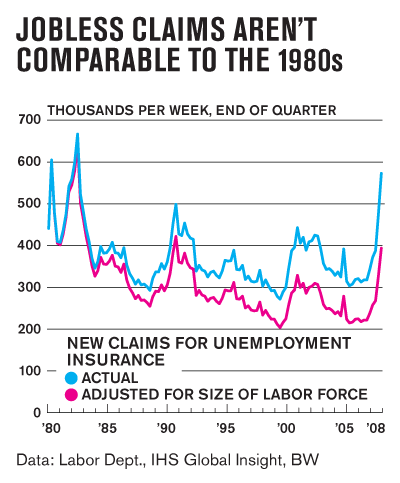
The talking heads of the media offer no help as they skew the unemployment numbers every chance they get so they can “GET” their headlines. Even the president is talking about the economy and unemployment numbers reaching levels not seen since the Great Depression. Really? What stats are they looking at? This is a sensitive topic as several of my family’s closest friends have lost jobs in recent months but the truth is the truth.
Business Week noted:
In the last year, the U.S. economy shed 3.4 million jobs. That’s a grim statistic for sure, but represents just 2.2% of the labor force. From November 1981 to October 1982, 2.4 million jobs were lost — fewer in number than today, but the labor force was smaller. So 1981-82 job losses totaled 2.2% of the labor force, the same as now.
Job losses in the Great Depression were of an entirely different magnitude. In 1930, the economy shed 4.8% of the labor force. In 1931, 6.5%. And then in 1932, another 7.1%. Jobs were being lost at double or triple the rate of 2008-09 or 1981-82. This was reflected in unemployment rates.
The latest survey pegs U.S. unemployment at 7.6%. That’s more than three percentage points below the 1982 peak (10.8%) and not even a third of the peak in 1932 (25.2%). You simply can’t equate 7.6% unemployment with the Great Depression.
Does the New High, New Low Ratio still work?
Of course it does but just keep in mind that it’s a longer term indicator rather than a short term buy and sell signal. I make today’s post due to what I am seeing with the NH-NL differential as it is starting to tread near positive territory for the first time in many months. The key for a sustainable bull market will be a push to a new 52-week high for this indicator.

“Chart provided courtesy of “DecisionPoint.com”
For a history of NH-NL posts, please see this category.
How about the foreshadowing provided in the post I made on August 21, 2007? Talk about calling a top!
According to Carl’s data, we must go back to 1998 to find a lower reading than last week’s NH-NL ratio. Even more amazing is the fact that we must then go back 20 to 38 years to find readings in the same vicinity as 1998 and 2007.
Ignoring the spike in 1987, we must visit the 1970’s to find readings below the -400 level on the chart.


Born and raised in New York but now living in New Jersey with a beautiful & loving wife, and two fantastic kids (boy and a girl). This site is about the stock market, success and life … [Read More...]
Copyright © 2025 on Genesis Framework · WordPress · Log in
Connect with Me